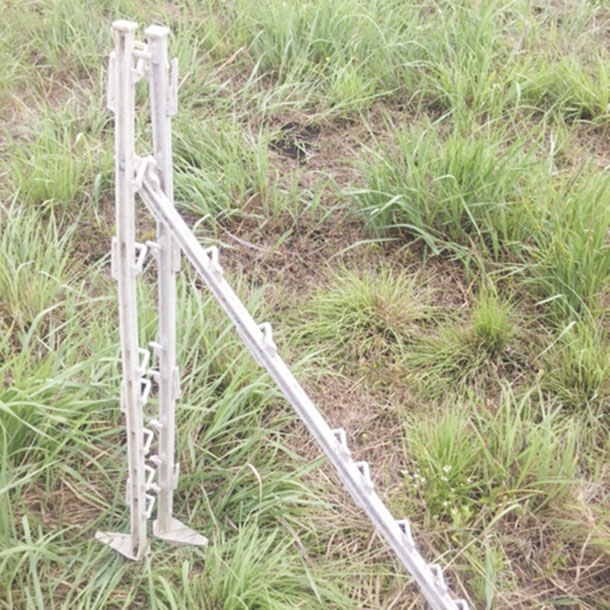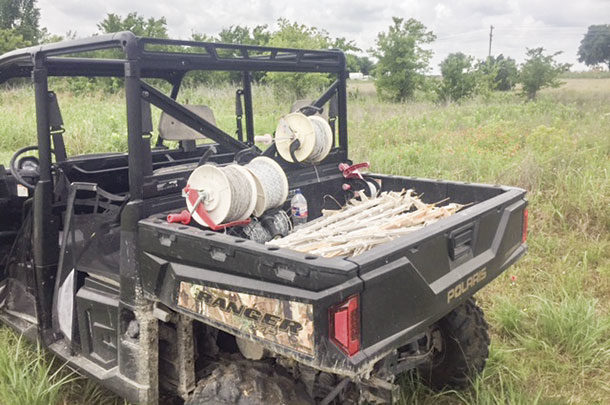Many stockmen who do a lot of rotational grazing create permanent paddocks with traditional fencing or electric hard wire (such as high-tensile electric wire) and then divide those paddocks with portable fencing like poly wire.
The portable fence can be moved every few days or even daily (or several times daily) to strip graze or mob graze. A person renting pasture may not want to invest in permanent fencing, just utilizing portable materials. There are many ways to create temporary fences.
Doak Elledge, ranching near Pampa, Texas, has worked with rotational grazing since the late 1970s. He says the basic infrastructure can be set up the way you want it with just two wires. “Mine are high-tensile, and one of those is a ground wire because of our dry climate,” Elledge says.
“Many people spend too much money for paddock fences. A five-strand barbed wire fence costs $9,000 per mile and is unnecessary. You can build a two-wire high-tensile fence for about one-sixth the cost, and it will work fine. Then you can use a number of great products for the temporary fences to split those pastures.”
Some producers use semi-permanent fence for paddocks that may be only 500 feet wide by 1 or 2 miles long and put temporary fence across those long strips. This gives flexibility at certain times of year – to move twice a day or whenever they need to move cattle.
A long, narrow pasture lends itself to quick and easy fence moving since the portable dividing fence is very short. Elledge tells of one stockman who divided all his meadows into long narrow strips and further divided them with temporary electric fence into segments less than an acre in size, moving the cattle five or more times each day.
Jim Gerrish, with American Grazinglands Services in May, Idaho, has been involved with innovative grazing systems for many years, first as a grazing specialist with the Forage Systems Research Center (University of Missouri) and now as a stockman and consultant in eastern-central Idaho, practicing these principles on the Circle Pi Ranch in the Pahsimeroi Valley.
He has very little permanent fence. He runs 500 pairs and moves them once a day, sometimes twice daily. “For me to walk out of the house, go to the pasture, move the fence and get back to the house takes about 45 minutes. If I ride the ATV, it takes about 25 minutes. I spend about as much time just walking out there as I do moving the fence,” he says.
It’s not very time-consuming if you plan it right. “Each time I move cattle, I am moving about 1,000 feet of poly wire. To take it down and set it up again for the next move takes about 20 to 25 minutes,” he says. He uses two fences, putting the next one up before he takes down the one in front of the cows.

“We lay everything out in strips. On a center pivot, these are round strips. On square fields, we lay out parallel strips,” says Gerrish. He likes working with strips 600 to 800 feet wide, up to a mile long. A strip 660 feet wide and a mile long is 80 acres.
If the cattle need 20 acres per day, it would take four days to get across one of those strips. “You might feed the grass off in 4- or 5-acre pieces by making several moves per day.” This gives flexibility to increase or decrease the number of moves per day.
“If you had a square section laid out in eight 80-acre strips, you’d be moving the same length of fence every day. It would probably take about 12 minutes to make the 660-foot shift,” he says. This makes the system very efficient.
Avoid designs where you’d have to move more than a quarter-mile of poly wire; a standard fence reel holds a quarter-mile. The number of step-in posts for that length of fence is fairly easy to carry. “If you go longer distances you need a bigger reel and more posts. It’s more awkward to get the job done in a short time,” Gerrish says.
If you have electric fence dividing a paddock and want to move cattle and leave the wire in place (and don’t have an electric gate handle), he suggests using a piece of PVC pipe (8 or 10 feet long) to lift up the wire and let the cattle walk under it. Once they learn they can go under the wire when you lift and prop it up, it’s easy to move the herd.
His son Ian Gerrish (Cobb Creek Farm, in Hillsboro, Texas) has been using portable fences since he was a kid helping his father move fences. He uses braided poly wire because he feels it’s more durable than anything else on the market as well as being easy to handle. He puts it on a geared reel for unrolling and rolling back up.
When moving fence, he generally takes posts out first, unhooks the wire and then reels it in like a fishing line. “This is not recommended because they say it will shorten the lifespan of the poly wire, but I have some I’ve been using five years, and it’s still not showing much wear. By contrast, I’ve used other types of wire that would completely fray out if you did this. Reeling it in this way saves a lot of time,” says Ian.
He uses O’Brien step-in posts because they are easy to put in without pounding, unless ground is really hard. There are also metal pigtail posts with a metal foot. “If the ground gets hard, you can use a hammer to tap them in. With metal posts, you can put more curve in your fence than you can with the step-in posts because they hold better.”
If he has to make a curve or corner with step-in posts, he has a unique way of bracing, using two posts facing opposite ways and then an angle brace with another post. “I’ve pulled quarter-mile runs from that pull point with no problems,” he says. ![]()
PHOTO 1: An ATV is equipped with wheels of poly wire and step-in posts to make rotational grazing moves less problematic and time-consuming.
PHOTO 2: Posts with a metal foot make it easier to hammer-tap the post in place. Photos by Ian Gerrish.
Heather Smith Thomas is a freelance writer based in Salmon, Idaho. Email Heather Smith Thomas.











